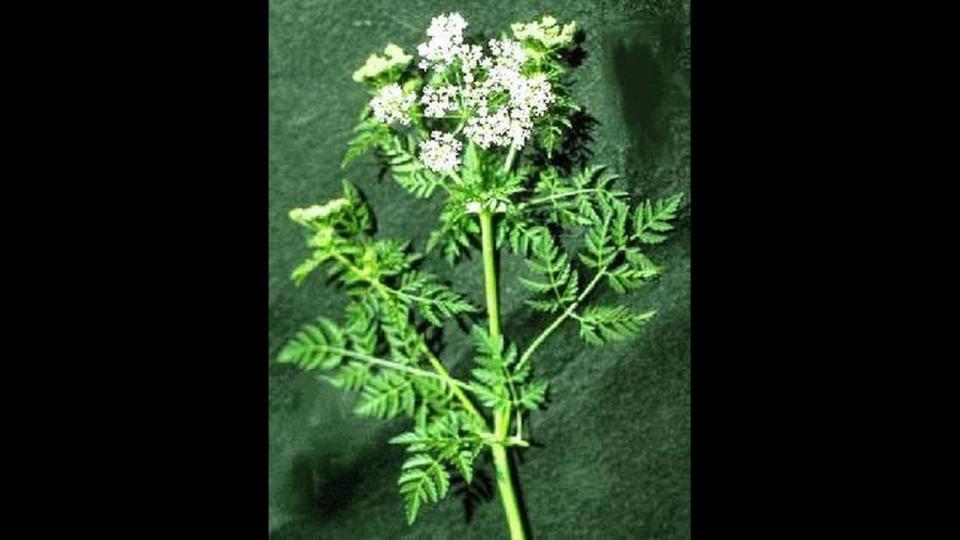This poisonous weed is growing in Wichita yards this summer. How you can identify it
A poisonous plant that bloomed in great numbers in the Wichita area last year has recently caught the attention of the public on online forums like Nextdoor.
Poison hemlock is an invasive plant found throughout North America since its introduction in the 1800s. With a two-year life cycle, the noxious weed is usually not noticed until the second year, when they can reach 4 to 10 feet tall.
In its first year, poison hemlock will stay ground-level and form rosettes and bundles of leaves. In its second year, it grows white flowers and can reach from 4 to 10 feet in height.

Because of the number of poison hemlock plants in bloom last year, Matthew McKernan, horticulture agent with the Sedgwick County Extension Office, expects most in the area this year to be in their ground-level phase.
“Right now people could definitely find poison hemlock in bloom,” he said. “I would suspect most people, because of the intense number of hemlock plants in bloom last year, most people are experiencing that first-year growth right now.”
Poison hemlock is usually found in ditches, tree lines and places that see less maintenance. While it is usually not found in landscaped areas, it can be.
It can cause serious reactions when ingested, including vomiting, seizures and respiratory failure. Many cases become fatal, the Cleveland Clinic reports.
Online discussion on NextDoor in Wichita started last week following a post warning others of the poisonous plant that garnered more than 90 reactions and an excess of 50 comments. People responding to the post shared other plants to look out for, while others mentioned seeing the plant and not knowing what it was.
Here’s what you need to know about identifying poison hemlock and removing it, plus how to tell if you may have ingested the plant.
How to identify poison hemlock and its look-alikes
Poison hemlock is most often confused with wild carrot, but there are distinguishing characteristics you should look for, McKernan said.
“One of the biggest differences between poison hemlock and wild carrot is the wild carrot is going to have hairs on the leaves, and poison hemlock is not going to have any hairs on the leaves,” McKernan said.
In its second year of growth, hemlock is easier to identify.
“When the plant gets bigger, it becomes easier to distinguish. Typically, wild carrot is only going to be 1 to 2 feet tall at maturity, while poison hemlock we would expect ... 4 to 10 feet tall, so much, much bigger of a plant when it’s in bloom,” McKernan said.
Poison hemlock also usually has purple speckles up the stem, while wild carrot doesn’t, McKernan said.
What to do if you find poison hemlock on your property
If you find what you suspect to be poison hemlock on your property, it’s best to get rid of it right away, as it’s also poisonous to wildlife and pets if ingested.
“We want to try to do what we can to reduce reproduction, and reduce flowering, because that is going to spread poison hemlock,” McKernan said.
There are two ways to get rid of hemlock: you can either dig it up or you can use herbicide. If the hemlock is around other plants you don’t want to harm, it’s best to dig it up.
To be safe, you should wear long sleeves and gloves when dealing with poison hemlock, as every part of the plant is poisonous, McKernan said. In some rare cases, people have had reactions to the plant through contact with open cuts or eyes.
When throwing the plant away, make sure to not burn it, as the smoke is also dangerous.
If you’re using herbicide, but want to protect the turf grass around the plant, McKernan recommends using 2-4-d-based herbicide or one with the active ingredient triclopyr.
“In areas where there’s bare ground or you don’t care about the vegetation growing there, you can use a nonselective herbicide,” he said.
Symptoms of contact with poison hemlock
Those who believe they have ingested poison hemlock should go to an emergency room or contact their health care provider as soon as possible.
According to the Cleveland Clinic, the symptoms of poison hemlock ingestion include:
Vomiting
Sweating
Dilated pupils
Rapid heartbeat
Dry mouth
High blood pressure
Increased salivation
Restlessness
Confusion
There is not a specific test used to diagnose hemlock poison, the Cleveland Clinic reports. If you’re having symptoms and ingested a wild plant, you should always show a picture of the plant to your health care provider.
The Cleveland Clinic said while reactions usually do not occur by just touching the plant, skin irritation can happen in those with sensitive skin.

